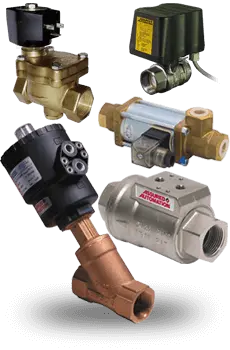What are Fugitive Emissions?
Fugitive emissions or FEs refer to the unintended release of environmentally harmful gases or vapors from industrial activities or facilities. It is estimated that 51% of these fugitive emissions have been attributed to valves.
In a typical facility most emissions are from valves and connectors, the most prevalent components, which often number in the thousands. Seal or gasket failure due to normal wear or improper maintenance is the major cause of these valve emissions.
Besides contributing to the loss of salable product, fugitive emissions pose a risk to the health and safety of workers as well as to the surrounding communities.
A Short Overview of Fugitive Emission Regulations
In October 1948, the mill town of Donora, Pennsylvania was covered by a toxic smog unintentionally released by the local steel manufacturing facilities.
After 5 days, the toxic gases resulted in the sickening of thousands and death of 20 in the community. Now considered one of the worst air pollution disasters in the nation’s history, the “Donora Incident” demonstrated the need for air pollution control and lead to the creation of the first clean air programs in the US.
In response to worsening industrial pollution the Environmental Protection agency (EPA) introduced the US Clean Air Act, the first federal legislation regarding air pollution control. Since that time increasingly stricter air pollution policies have been implemented at the US Federal and State levels.
Germany also began instituting air pollution control regulations in 1964 titled “Technical Instructions on Air Quality Control” (Technische Anleitung zur Reinhaltung der Luft) commonly referred to as the TA Luft.
During the late 1980s, EPA legislation was amended to include petroleum refineries and chemical processing plants that emit volatile organic compounds (VOC’s) and hazardous air pollutants (HAPs). The agency began conducting audits in hopes that companies would willingly implement emissions reductions.
In order to reduce the emission of fugitive VOCs and HAPs, the EPA instituted Leak Detection and Repair (LDAR) regulations, a system of procedures a facility utilizes to locate and repair leaking components which includes EPA Method 21, a method for determining VOC leaks from process equipment in parts per million. EPA Method 21 pertains to valves, flanges and other connections, pumps and compressors, pressure relief devices, process drains, open-ended valves, pump and compressor seal system degassing vents, accumulator vessel vents, agitator seals, and access door seals.
By the late 1990’s, the EPA determined that many facilities were under-reporting emissions, failing to implement Method 21 sufficiently to meet emission reduction targets.
It was estimated that 40,000 tons of VOCs were being emitted annually from valves of petroleum refineries alone. By the early 2000’s many refineries agreed to implement official LDAR Programs to avoid litigation.
Fugitive Emissions Valve Standards
When facilities do not meet the EPA’s Clean air requirements, consent decrees are negotiated with the manufacturing facility, typically resulting in the implementation of a formal Leak Detection and Repair (LDAR) program which implements Method 21 valve VOC monitoring.
Currently, It is believed that 80% of fugitive emissions from valves are emitted through the valve stem of linear valves (gates and globes) due to the rising/rotating of the stem through the packing system and the difficulty of proper sealing.
As the EPA continues to refine its standards for the LDAR process there is a push that new valves used in refineries to be certified as “Low E Technology”. The EPA defines a Low E Valve as:
A valve (including its specific packing assembly) or valve packing for which the manufacturer has issued a written warranty that it will not emit fugitives at greater than 100 ppm, and that, if it does so emit at any time in the first five years, the manufacturer will replace the valve
The push for “low Emissions Valves” and “low Emissions Packing” has prompted many standards organizations such as API, ANSI, ISO, MESC, ANSI and TA-Luft to establish valve and packing test standards which assess fugitive emission performance.
Examples of Fugitive Emissions valve standards:
American Petroleum Institute Standards (API) currently has three valve/packing emissions standards tests.
- API 622 Type Testing of Process Valve Packing for Fugitive Emissions. This is a test of the valve packing alone.
- API 624 Type Testing of Rising Stem Valves Equipped with Graphite Packing for Fugitive Emissions. This test evaluates the total performance of the valve, not just the valve packing, The Packing used in an API 624 test must have passed API 622 Requirements.
- API 641 Type Testing of Quarter-turn Valve for Fugitive Emissions. This is the type test for quarter turn valve designs evaluating low emissions performance over an accelerated life cycle
International Organization for Standardization
According to ISO testing guidelines the test media must be methane and the test method must be EPA’s Method 21. The EPA has determined that methane is the most destructive to the environment.
- ISO 15848-1:2015 (Type Testing) specifies testing procedures for evaluation of external leakage of valve stem seals (or shaft) and body joints of isolating valves and control valves intended for application in volatile air pollutants and hazardous fluids.
- ISO 15848-2:2015 (Production Test) specifies test procedures for the evaluation of external leakage of valve stems or shafts and body joints of isolating valves and control valves intended for application with volatile air pollutants and hazardous fluids.
TA Luft -German Technical Guidelines for Air Pollution
- Guideline VDI 2440 refers to average gas-like emissions for differing gasket systems.
A much less stringent standard compared to ISO 15848, TA Luft only deals with the sealing system of the stem passage with very general testing requirements.
Solutions from Assured Automation
Low Fugitive Emission Valve Selection
/low-fugitive-emission-valves/
XP3 Low Fugitive Emission Plug Valves
/XP3/
HPX Low Fugitive Emission Butterfly Valves
/HPX/
FEX Fugitive Emission Containment Packs for Ball Valves
/fugitive-emission-containment-pack/
DSI-37XUF Low Fugitive Emission Gate Valves
/DSI-gate-valve-37XUF/index.php
Related Article:
Upgrade Your Valves to Reduce Your Fugitive Emissions…
Making the Case for the Cost of Upgrades



